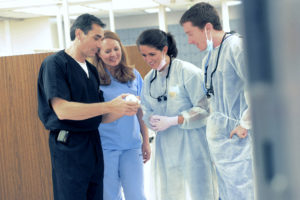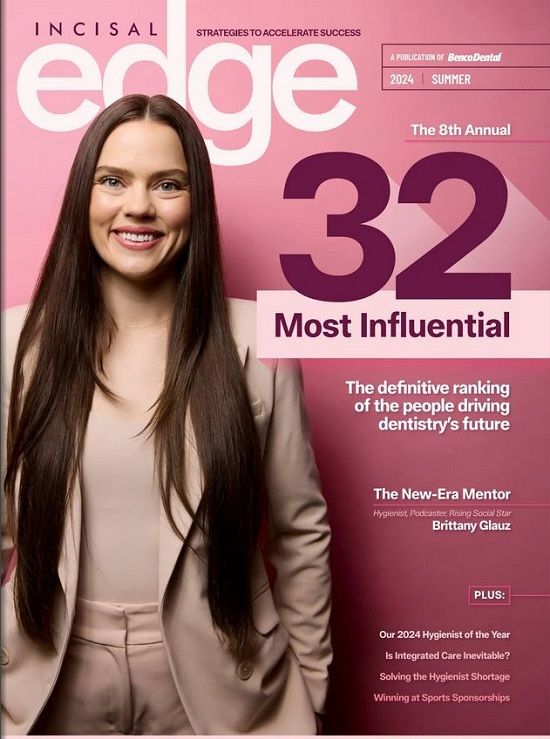SMALL BUT MIGHTY, THE UNIVERSITY OF ALABAMA AT BIRMINGHAM IS TRANSFORMING AN ENTIRE INDUSTRY THROUGH ITS RELENTLESS FOCUS ON DENTAL RESEARCH.
BY MELANIE BAVARIA
THE BEST DENTAL TECHNOLOGY, it hardly needs to be said, is of limited utility without the research bona fides to back it up. One small, formerly under-the-radar Southern dental school has become the perhaps unlikely standard-bearer of that truism.
The University of Alabama at Birmingham’s dental program is of modest proportions. It enrolls 60 or so students every year; the average U.S. dental school enrolls 90, according to the most recent figures from the American Dental Education Association. For the past five years, though, UAB has received more funding, dollar for dollar, from the National Institute of Dental and Craniofacial Research (part of the federal National Institutes of Health) than any dental school in the country. Perhaps more significantly, it’s also home to the National Dental Practice-Based Research Network.
That organization comprises thousands of dental practices across the U.S. that participate in a variety of collaborative projects. Its mission statement avers that the group offers “research done about and in the ‘real world’ of daily clinical practice.”
Why is this important? Dental research of all kinds is going on constantly, of course, but there’s often a disconnect between what’s being studied in a lab and what’s of use in the operatory. A lot of research, the NDPBRN claims, is “scientifically valid, statistically significant, but clinically useless” — a defect it intends to address. And UAB is the central locale from which to do just that.
Dr. Michael Reddy, a periodontics specialist who since 2012 has been dean of the UAB School of Dentistry, observes that one additional research roadblock is the vast amount of time it takes to affect patient outcomes. “When a scientific discovery is made, some estimate it may be upward of 12 to 18 years before it’s adopted in clinical practice,” he says. “That’s startling. With the [NDPBRN] network, we can quickly push information to these practices that are engaged in the science, but also collect data from them” — a virtuous cycle of experimentation and results-sharing that offers the possibility of shortening that lab-to-clinic timeline considerably.
The NDPBRN was cooked up in 2012, when the university received a $66.8 million NIDCR grant to consolidate an existing system of three U.S. regional networks that had been created five years earlier. It’s now under UAB’s umbrella as a single national network, so its members’ ability to conduct immersive research and get the results to practitioners is far more efficient than before.
Dr. Reddy illustrates: “We have almost 7,000 practices enrolled in the network,” he says. “So say you wanted to look at an outcome in hundreds of thousands of patients in a clinical trial. That would take an incredible amount of resources to recruit them and have centers agree to do it. But with the network, we can open a study. I enroll 10 patients, you enroll 10, someone else gives us 10, and we can find the answer from the people we’re seeing in practice. We see what works and what doesn’t.” (Patients must opt in and are therefore participating with full knowledge of their role.) UAB Dental figures show that the network overall has conducted more than 50 studies and has published extensively, with 114 papers in print and eight currently under review. “This model of research,” Dr. Reddy says, “has transformed the dental profession.”
Being the lodestar of the NDPBRN is a source of pride for Dr. Reddy, indicative of the impact UAB is having on the broader national conversation about dental research. “It gives people in clinical practice, as well as clinical researchers, a way to put into the system ideas and problems that need to be solved,” he says. “A lot of our concepts come from people practicing dentistry.

Its higher profile also stems from its broader mission to expose students to research opportunities and encourage them to think of themselves not just as practitioners but part of a larger scholarly community. “For the students, it gives them the sense of going beyond the basics of evidence-based dentistry [to] where they understand research,” Dr. Reddy says.
This focus on research extends to the curriculum — and beyond. Not only are all UAB Dental students required to complete a research project and present it publicly, but about 5 percent of students, Dr. Reddy says, go on to publish a peer-reviewed paper. UAB alumni are also, understandably, disproportionately represented in those practices engaged with the NDPBRN.
Its curriculum requirements “immerse all graduating dentists in scientific methods, data collection and analysis, and presentation of scholarly work,” school directives state. “It also solidifies, for students, the concepts that learning is based on knowledge, and all knowledge is the result of research, and that an ability to articulate the evidence for what we do and how we treat patients is part of being a doctor.”
Such high-minded sentiments reflect Dr. Reddy’s overarching goal, which is, he says, to produce professionals whose mantra is clear: “Of course I do research. I’m a dentist.”



